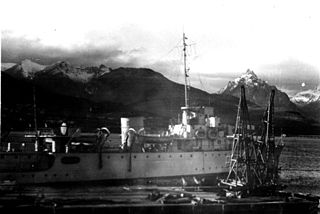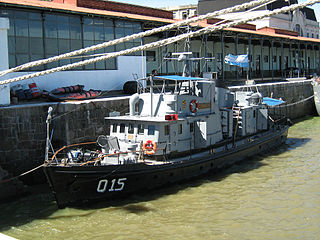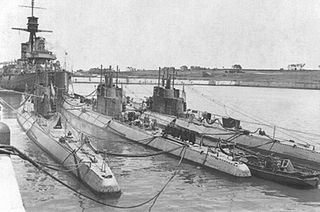
USS Cahuilla (ATF-152) was an Abnaki class fleet tug in the service of the United States Navy during World War II. In 1961 she was sold to the Argentine Navy as ARA Irigoyen (A-1) where she served until 2009 when she became a Museum ship.

ARA Bahía San Blas is an amphibious cargo ship of the Argentine Navy, capable of unloading landing craft, troops, vehicles and cargo. She is the first Argentine Navy ship to bear the name of San Blas Bay of in the south of Buenos Aires Province.

ARA King is a World War II-era Argentine Navy warship, originally classified as minelayer and later as patrol ship. The vessel is named after Juan King, an Argentine naval officer that served in the Cisplatine War. It is the third Argentine naval ship with this name.

ARA Cormorán (Q-15) is a hydrographic survey boat of the Argentine Navy, built in the Río Santiago Shipyard and based in Buenos Aires. The vessel is named after the cormorant, a seabird that inhabits Argentina’s littoral, and is the fourth Argentine naval ship with this name.
ARA Petrel was a hydrographic survey boat of the Argentine Navy, built in the Cadenazzi Shipyard and based in Buenos Aires. The vessel is named after the petrel, a seabird that inhabits Argentina's littoral, and is the third Argentine naval ship with this name.

ARA Zurubí (P-55) is a patrol boat of the Argentine Navy, built in the Río Santiago Shipyard in 1938 and based in Ushuaia. The vessel is named after the Surubí, a catfish that inhabits Argentina’s Mesopotamia, and is the first Argentine naval ship with this name.
ARA Azopardo was a steam transport of the Argentine Navy, built in the Stabilimento Tecnico Triestino and sold to Argentina in 1884. It was based, among others, in the port of Buenos Aires and later Ushuaia, and was decommissioned in 1922 after being sunk in an accident; it was refloated and sunk in 1924 as a target. The vessel was named after the Juan Bautista Azopardo, a Maltese privateer and officer of the Argentine Navy during the Independence and Cisplatine wars, and was the first Argentine naval ship with this name.

The Murature-class patrol ships are a class of World War II era Argentine Navy warships, originally classified as minelayers and later reclassified as patrol ships. The class is named after José Luis Murature, Foreign Minister of Argentina from 1916 to 1918.

The Azopardo-class frigates were a class of two post-World War II warships, designed and built in Argentina in 1940-1959, originally as part of a class of four large minelayers. They were in service with the Argentine Navy from the mid-1950s to 1972. The class was named after Juan Bautista Azopardo, an Argentine naval officer in the Independence and Cisplatine wars.

The Santa Fe-class submarines, also known as the Tarantinos after the city in which they were built, were a class of three pre-World War II submarines, designed and built in Italy in 1928-1933, as part of an Argentine expansion plan for its navy. They were in service with the Argentine Navy from the early 1930s to the late 1950s. The class was named after Argentine provinces starting with “S”, as traditional in the Argentine Navy.

ARA Cabo de Hornos (B-5) was a cargo ship in service with the Argentine Navy since 1979, capable of transporting bulk cargo, live cattle, and containers. She was the second ship in the Argentine Navy to bear the name of the Cape Horn (Chile) located to the south of Tierra del Fuego.

ARA Canal Beagle (B-3) is a cargo ship in service with the Argentine Navy since 1978, capable of transporting bulk cargo, live cattle, and containers. She is the second ship in the Argentine Navy to bear the name of the Beagle Channel in the south of Tierra del Fuego.

The Costa Sur-class cargo ship is a class of three cargo ships designed and built in Argentina in 1975–1979 for servicing the Patagonic coast routes; capable of transporting bulk cargo, live cattle, and containers. The ships have been in service with the Argentine Navy since 1978. The class is named after the southern coastal area of Argentina which was designed to service.

ARA Punta Alta (Q-63) is a multipurpose auxiliary ship of the Argentine Navy, built in the Curtis Bay Shipyard, United States, in 1964; transferred to Argentina in 2000, she is based at Puerto Belgrano. The vessel is named after the Argentine city of Punta Alta, which is close to Puerto Belgrano, and is the second Argentine naval ship with this name.
ARA Santa Cruz was an auxiliary ship of the Argentine Navy, built in the Fairfield Shipbuilding & Engineering Shipyard, Govan, Scotland, in 1921. She was transferred to the YPF tanker fleet after arrival in Argentina, and remained in YPF service until decommissioned and scrapped in 1948. The vessel was named after the Argentine province of Santa Cruz, and is the ninth Argentine naval ship with this name.
ARA Punta Médanos (B-18) was an auxiliary ship of the Argentine Navy, a tanker built at the Swan, Hunter & Wigham Richardson shipyard, Wallsend, in 1950. While in naval service she made several commercial trips supplementing the YPF tanker fleet, and supported the high seas fleet; in this capacity Punta Médanos participated in the Falklands War in 1982. She was decommissioned in 1984 and sold for scrapping. The vessel was named after the coastal feature of Punta Médanos, Argentina, and was the first Argentine naval ship with this name.
ARA Luisito (Q-51) is a training ship of the Argentine Navy, in service since 1985 and based in Mar del Plata; where she is used to train students from Argentina’s National Fishing School. The vessel is the first Argentine naval ship with this name.











